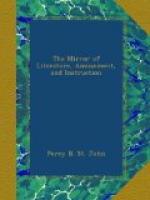The stories of the young lady suffocated by accidentally enclosing herself in a chest with a spring lock[7]—of the girl frightened into complete idiotcy by those who placed a skeleton, or, as some say, a skull only, in her bed[8]—and of ladies, bishops, &c. obtaining their livelihoods privately by highway robbery[9], with similar narratives, rather romantic than superstitious, are general property, and to be met with under various modifications throughout England. The tale of the King of the Cats[10], a German tradition, has its exact counterpart in an Irish one, related to us as an original Hibernian legend, and published some time since in an excellent work, which having now disappeared, we may perhaps venture to give, as a novelty, the little tradition in these pages:
A man passing, late at night, a ruined house, observed that it was lighted, and heard a great mewing, as of a conclave of cats, within. As he marvelled at the circumstance, a cat jumped upon one of the broken walls, and said—“Tell Dildrum that Doldrum’s dead.” The man, little dreaming of these words being addressed to him, pursued his way home; where, when he arrived, a good, fire, an excellent supper, and his wife’s conversation, seem to have banished for a time from his recollection what he had seen and heard. At last, he began to laugh so heartily that he was nearly choked, and his wife pressed him to tell her the cause of his mirth. This he did; but no sooner had he uttered the words “Tell Dildrum that Doldrum’s dead,” when his own favourite grimalkin, who had lent an attentive ear to his narrative, whilst demurely basking before the fire, started upon his feet, and exclaiming, “O murder! and is Doldrum dead?” dashed up the chimney, and was never seen more.
[7] Vide Mirror, vol. ii.
p. 157, for the story of “The Rosewood
Trunk.”
[8] Vide Mirror, vol. v. p. 93, for the story of “Mary M’Cleod.”
[9] Vide Mirror, vol. viii.
p. 90, for the story of “The Lady of
Edenmere”—by the author of
this article.
[10] Vide Mirror, vol. xii.
p. 267, for the “Ghost Story”—by
M.G. Lewis.
A Scottish tradition concerning The Cat o’ the Craigs, as given by a correspondent in vol. iv. of the Mirror, p. 85, and which has a most fatal termination, is evidently but another version of the same story.




